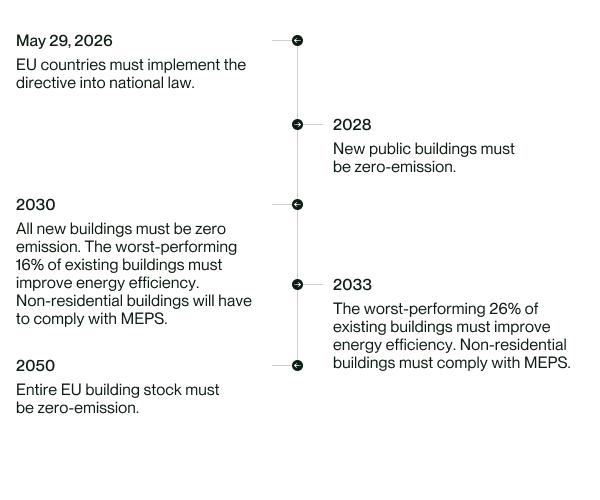Home – Regulations – EPBD – Energy Performance of Buildings Directive
EPBD – Energy Performance of Buildings Directive

Home – Regulations – EPBD – Energy Performance of Buildings Directive

The Energy Performance of Buildings Directive (EPBD) is a key piece of EU legislation aimed at improving the energy efficiency of buildings across the European Union. As buildings account for approximately 40% of total energy end use in the EU, the directive plays a crucial role in the EU’s climate and energy goals. The latest revision introduces stricter requirements to ensure that all new buildings are zero-emission from 2030, with additional measures targeting the renovation of existing structures.
The EPBD is an EU directive that mandates energy performance improvements in both new and existing buildings, ensuring they meet higher energy efficiency standards. Its goal is to make all new buildings zero-emission from 2030. The existing building stock should be transformed to zero emission buildings by 2050, and certain improvement of the worst-performing existing buildings should be achieved by 2030 and 2033 for non-residential buildings and by 2030 and 2035 for residential buildings.
The EPBD was introduced in 2002 as part of the EU’s commitment to reducing greenhouse gas emissions and improving energy efficiency. Over the years, cutting CO2 emissions from the property sector has become more important, and the directive was revised and agreed in May 2024, with a significantly increased stringency of energy efficiency targets. The latest revision aligns with the EU Green Deal and the Fit for 55 package, reinforcing the commitment to climate neutrality by 2050.
The directive sets mandatory targets for energy performance improvements, with compliance enforced at the national level. Each EU member state must transpose the directive into national law by May 29, 2026.
All companies operating within the EU’s real estate and construction sectors must comply with the national implementation of EPBD. The requirements apply to all actors. Publicly owned buildings must meet requirements earlier (2028). Real estate, construction, and building management sectors will also be significantly affected.
The directive impacts:
Each member state can decide on accepted exemptions, e.g. building with particular cultural value.

To comply with the Energy Performance of Buildings Directive (EPBD), property owners and developers must ensure that all new buildings meet zero-emission standards, reflecting the directive’s ambition to decarbonise the building sector. Existing buildings, particularly non-residential ones, must be upgraded to meet Minimum Energy Performance Standards (MEPS), while the worst-performing residential buildings are expected to undergo energy renovations to improve their efficiency.
In addition to improving building envelopes and systems, compliance also involves the integration of renewable energy sources, such as solar panels, to reduce reliance on fossil fuels. Developers are also required to support sustainable mobility by installing electric vehicle (EV) charging infrastructure and providing adequate bicycle parking, helping to align buildings with broader climate and transport goals.
Implementing the EPBD directive is mandatory for the EU member states, but the member states may design the implementation. Zero-emission standards for new buildings are mandatory. Some energy-saving incentives may be voluntary at the national level.
One of the biggest challenges in complying with the EPBD is the high investment cost of upgrading older buildings, particularly for owners of large property portfolios. Many buildings will require significant renovations, including improved insulation, upgraded heating and cooling systems, and the integration of renewable energy sources such as solar panels. However, most of the necessary energy-efficiency measures are cost-efficient from a life cycle perspective.
Access to financing is another major barrier, as property owners and developers must secure funding for these energy efficiency upgrades while ensuring a return on investment. Additionally, the availability of renewable energy supply and infrastructure, such as EV charging points, poses logistical and technical challenges, particularly in urban areas with space constraints. Meeting stricter performance standards while balancing operational costs will require careful planning, strategic investments, and for certain measures government support.
Organisations should conduct an energy audit to assess current compliance, develop a strategy for upgrading buildings, and invest in energy-efficiency measures and renewable energy infrastructure to meet the EPBD requirements.
Future developments in the EPBD are likely to include further tightening of energy efficiency regulations, pushing buildings to adopt even more sustainable practices. There is also expected to be a greater emphasis on digital building energy monitoring systems, enabling real-time tracking of energy performance. Additionally, financial incentives for compliance may expand, providing more funding opportunities for businesses and property owners to implement energy-efficient upgrades.
With these ambitious requirements, property owners and developers must act now to develop strategies and action plans for their portfolios. Anthesis supports the property sector to develop strategies, navigate compliance challenges, optimise energy performance, and achieve EPBD targets effectively.
We are the world’s leading purpose driven, digitally enabled, science-based activator. And always welcome inquiries and partnerships to drive positive change together.
We’d love to hear from you